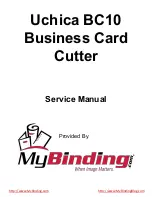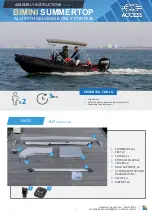
Note
Incorrect specification values of the braking ramp in STOP situations (e.g.
EMERGENCY STOP, Quick Stop) result in an overloading of the linear axis and can
destroy it or drastically reduce the service life.
· Check the settings of all braking ramps in your controller or the higher−level
controller (deceleration values and jerk).
· Make sure that the deceleration values (braking deceleration, deceleration
times), taking into account the speed of travel, moving load and mounting
position, are set so that the maximum drive torque or maximum feed force of
the linear axis used are not exceeded.
· To design the linear axis, use the Festo design software Positioning Drives"
(
è
www.festo.com).
Note
Block−shaped acceleration profiles (without smoothing) cause high peaks in the
drive force, which can result in drive overload. In addition, through overswing
effects, positions outside the permissible range can occur. A smoothed
acceleration specification reduces vibrations in the overall system and has a
positive effect on the mechanical equipment load.
· Check which regulator settings can be adjusted (e.g. smoothing, flattening of
the acceleration profile).
Note
The elasticity of the toothed belt delays the acceleration behaviour of the ELGR
and results in larger accelerations than are set on the controller (spring effect).
· Take into account possible deviations from the acceleration set at the
controller.
1. Check travel
2. Homing
3. Test run
Determining the
direction of movement of
the motor
Adjusting the real
situation with the image
in the controller
Checking the complete
behaviour
Fig.13: Definitions
1. Start
check travel
with low dynamics.
In spite of equal control, motors of the same type sometimes turn in the
opposite direction due to the circuitry.
2. Start
homing
in accordance with the operating instructions for your motor drive
system with low dynamics up to the reference switch.
3. Start a
test run
with low dynamics.
4. Check whether the ELGR fulfils the following conditions:
The slide unit must be able to move through the complete intended
positioning cycle.
The slide unit must stop as soon as it reaches a limit switch.
5. If the proximity switches do not respond:
è
chapter11 Eliminating faults" and
the operating instructions for the proximity switches.
7
Operation
Warning
Moving masses can cause personal injury and material damage (crushing).
· Make sure that, in the positioning range:
nobody can place his/her hand in the path of the moving load
(e.g.by providing a protective screen),
there are no objects obstructing the positioning path.
It should not be possible to touch the ELGR until the mass has come to a
complete standstill.
If the motor is turned around:
Note
When the motor is removed (e.g.
turning the motor) the reference
position is lost.
· Start homing as detailed in the
chapter Commissioning" in order
to set the new reference position.
Fig.14
8
Care and maintenance
Warning
Moving masses can cause personal injury and material damage (crushing).
If a toothed belt breaks in combination with a vertically or diagonally fitted ELGR,
the work mass will fall down.
· Send the ELGR to Festo for repairs when there are signs of wear.
Controller signals can cause the ELGR to make unintentional movements.
· For all maintenance work on the ELGR, switch off the controller and secure it
to prevent it from being switched back on unintentionally.
On cleaning and care:
· Clean the ELGR as required with a soft cloth.
Use any non−abrasive material as a cleaning agent.
Relubrication of the ELGR is not permitted.
· Regularly check the play in the plain−bearing guide according to your
application. Depending on the load, the guide backlash rises with increasing
duration of operation.
9
Disassembly and repairs
Note
Retensioning of the toothed belt reduces its service life considerably. In
addition, the technical specifications, e.g. the feed constant, will be modified.
· Make sure that the toothed belt has not been retensioned.
The toothed belt is pretensioned so that it does not have to be retensioned
during its life.
· Recommendation: Return the ELGR to our repair service.
This ensures that special attention will be paid to the necessary fine
adjustments and inspections.
· Information on spare parts and aids can be found under:
www.festo.com/spareparts
10
Accessories
Note
Please select the appropriate accessories from our catalogue
è
www.festo.com/catalogue
11
Eliminating malfunctions
Malfunction
Possible cause
Remedy
Squeaking
noises,
vibrations or
rough running
The coupling is fitted too
tight
Adhere to the permitted coupling
spacing dimensions
(
è
assembly instructions for the
motor mounting kit)
rough running
Distortions
Fit ELGR free of tension
(Pay attention to evenness of the
mounting surface
è
chapter
Fitting mechanical components")
Modify speed of travel
Incorrect regulator
settings
Modify the regulator parameters
Defective bearing
Send ELGR to Festo for repairs
Toothed belt or slide
elements worn
p
Slide unit does
Too much load
Reduce load mass
not move
Reduce positioning speed
Clamping hub spins
Check how the motor mounting kit
is fitted (coupling)
Slide unit
travels beyond
the end
position
The proximity switches
do not react
Check the mounting level of the
proximity switches, connections
and controller
Toothed belt
jumps off
Toothed belt
pretensioning too low
Send ELGR to Festo for repairs
j
p
Incorrect regulator
settings
Modify the regulator parameters
Too much load
Reduce load mass
Reduce positioning speed
Fig.15







































